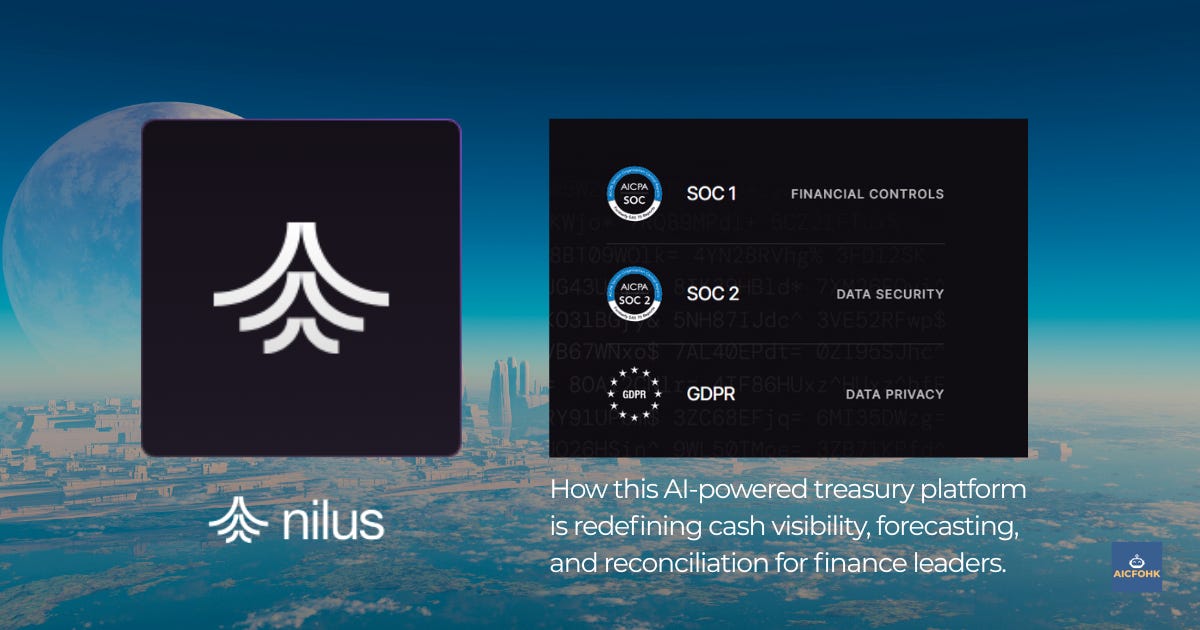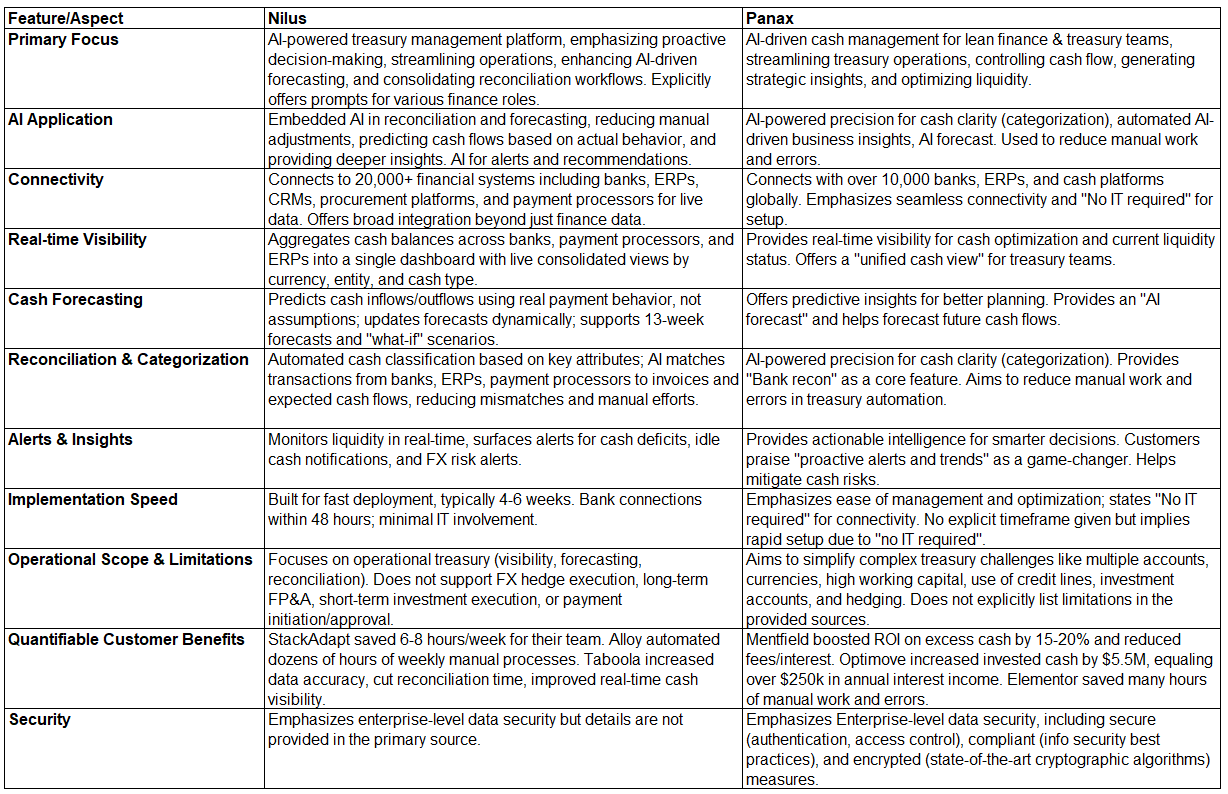Nilus AI: Transforming Treasury Management (Updated)
How an AI-powered treasury platform is redefining cash visibility, forecasting, and reconciliation for finance leaders.
Managing cash has historically been more complex than necessary for finance teams, largely due to balances being scattered across various banks, currencies, and systems, leading to a lack of real-time visibility. This fragmentation of data, reliance on manual processes, and outdated forecasts make it challenging for companies to anticipate liquidity needs, often resulting in delayed and misinformed decisions regarding working capital, debt, and investments.
Nilus, co-founded by fintech veterans Daniel Kalish (ex-PayPal) and Danielle Shaul (ex-Fundbox), addresses these issues head-on. As of January 16, 2025, Nilus has secured an additional $10 million in funding, bringing its total funding to $18.6 million. This investment aims to accelerate the development of Nilus's platform, which is designed to simplify treasury operations, enhance AI-driven forecasting, and streamline cash management for finance teams. Nilus currently manages billions in cumulative cash for a diverse client base, ranging from mid-size businesses to publicly traded companies, including Alloy, Taboola, Made In Cookware, Planned Parenthood, and StackAdapt.
Nilus's core mission is to "free finance teams from operational headaches so they can focus on what truly matters — proactive decision-making". The platform empowers finance leaders to answer critical strategic questions such as
"Am I on track to meet my financial guidance?", "Can we better manage working capital?", and
"How can we effectively plan for FX fluctuations?".
Nilus helps save finance teams hundreds of hours by automating manual tasks, allowing them to concentrate on strategic decisions and reduce liquidity risks.
Nilus differentiates itself in the treasury management space through three key innovations:
Seamless integration of treasury and cash reconciliation workflows across the organization, providing greater value through a single collaborative tool for treasury, accounting, and FP&A.
Rapid deployment and Excel-like functionality, ensuring ease of use and quick adoption by teams.
Embedded AI in reconciliation and forecasting, which helps teams avoid risk and predict future cash flows and liquidity needs with greater accuracy. This built-in intelligence provides deeper insights, enabling more informed decisions and proactive management of financial risks.
Why Cash Forecasting Remains Difficult and How Nilus is Fixing It
Historically, cash forecasting has been theoretically simple but challenging in practice, often relying on static ERP reports and invoice due dates. This traditional approach assumes that customers will pay on time, vendors will adhere to agreed terms, and bank balances accurately reflect available cash. However, in reality, customer payments are often late, vendor settlements vary, and cash is dispersed across numerous entities and accounts.
Nilus overcomes these challenges by connecting to over 20,000 financial systems, including banks, ERPs, CRMs, procurement platforms, and payment processors, to pull live data from across the financial stack. This comprehensive connectivity allows Nilus to provide an up-to-date snapshot of cash activity.
The evolution of treasury technology highlights the need for modern solutions:
Legacy Treasury Management Systems (TMS), such as Kyriba, ION, or Sungard, were designed for static workflows and required manual reconciliation and forecasting adjustments.
Second-generation platforms improved by adding ERP integration but still relied heavily on spreadsheets for modeling.
Next-gen solutions, like Nilus, extend beyond traditional finance data by integrating with procurement, sales, and payments to enable real-time forecasting based on actual business activity.
With Nilus:
Forecasts dynamically update based on actual customer and vendor payment behaviors rather than mere assumptions.
Global cash positions are consolidated into a single dashboard.
AI-driven reconciliations significantly reduce manual adjustments.
This shift enables treasury teams to move from reactive data chasing to proactive action based on insights. Unlike legacy platforms that might take months to implement, Nilus is typically operational within weeks.
Core Capabilities
Nilus offers several core capabilities that transform treasury operations:
Real-time Cash Visibility & Liquidity Management: Nilus aggregates cash balances across banks, payment processors, and ERPs into a single, unified dashboard. Treasurers gain a live, consolidated view of liquidity, organized by currency, entity, and cash type (operational, restricted, or reserved). This eliminates the need to switch between multiple systems to understand cash positions. Nilus also monitors FX exposures across currencies, enabling treasurers to rebalance or hedge proactively when risks arise. For example, StackAdapt managed 3 banks, 7 currencies, and 35 accounts with Nilus, while Taboola handled 15 banks, 18 currencies, and over 100 accounts.
AI-Powered Forecasting: A Smarter Approach to Cash Planning: Nilus predicts cash inflows and outflows by analyzing real payment behavior instead of relying on fixed assumptions. This means:
Open sales invoices adjust expected inflows based on actual customer payment patterns.
Vendor payments reflect past settlement trends, not just due dates.
Bank settlements update cash positions in real time. Treasury teams can build 13-week forecasts, blend historical data with upcoming obligations, and test "what-if" scenarios (e.g., delayed collections, early payments). Nilus runs these forecasts dynamically using AI, aligning planning more closely with actual operations and moving short-term liquidity decisions beyond rough spreadsheet estimates. Nilus introduced its AI-powered forecasting in 2024, enhancing the accuracy of bottom-up cash planning.
Transaction Tagging & AI Categorization: Nilus automates cash classification by labeling transactions based on key attributes like vendor, payment type, currency, and cash flow category. This eliminates manual classification and reliance on outdated rules. Its AI also matches transactions from banks, ERPs, and payment processors to invoices and expected cash flows, speeding up reconciliation, improving financial reporting accuracy, and minimizing manual efforts to identify discrepancies.
Treasury Alerts & Recommendations: Nilus continuously monitors liquidity in real-time and provides alerts for critical issues:
Cash Deficit Warnings: Alerts trigger when outflows are expected to exceed inflows, prompting actions like adjusting payment schedules, transferring funds, or accelerating collections.
Idle Cash Notifications: Nilus identifies excess cash in accounts and recommends reinvestment or reallocation opportunities.
FX Risk Alerts: Warnings are issued when foreign currency positions become imbalanced, allowing teams to rebalance funds, hedge FX risks, or manage intercompany transfers to limit exposure.
Collaborative Workflow Management: Nilus centralizes workflows for receivables, reconciliations, and approvals, which typically get fragmented across spreadsheets and emails. Payment records, collection notes, and reconciliation data are attached directly to each transaction. Treasury and collections teams can tag colleagues, track decisions, and log follow-ups within the platform, ensuring visibility for all relevant parties. For example, if a large overdue invoice is flagged, the treasury team can tag the collections team in Nilus, add payment history, and facilitate a collaborative decision on next steps, all with recorded visibility.
Implementation and Pricing
Implementation: Nilus is designed for fast deployment, typically going live within 4-6 weeks, a significant improvement over the 6-12 months often required by legacy TMS platforms. Bank connections are completed quickly, often within 48 hours, using APIs, SFTP, or open banking. Workflows can be configured directly by treasury teams, minimizing the need for IT involvement.
Pricing: Nilus employs a modular, subscription-based pricing model. Costs are based on the selected capabilities (e.g., cash visibility, forecasting, reconciliation), the number of bank connections required, and the depth of integrations with other platforms like ERPs, CRMs, PSPs, or procurement systems. This model avoids heavy upfront costs or rigid contracts, allowing teams to pay only for the functionality they need.
Limitations (for now)
While Nilus excels in operational treasury, focusing on cash visibility, forecasting, and reconciliation, it does have specific limitations:
FX and Hedging: Nilus tracks cash in different currencies and flags imbalances, but it does not support hedge execution or manage derivatives. Teams requiring these functions would still need a dedicated FX platform.
FP&A and Long-term Planning: Nilus's cash forecasts typically look weeks or months ahead, not years. Long-term budgeting, enterprise scenario planning, and capital structure modeling require dedicated FP&A platforms.
Cash Investments: While Nilus identifies idle cash, it does not support short-term investing. Moving excess funds into instruments like T-bills or money market funds still occurs via the bank or an investment portal.
Payment Execution: Nilus tracks which payments have cleared and when, but it does not initiate or approve payments. Approval flows for vendor batches, for example, happen within the ERP or bank portal.
Bonus: Nilus vs. Panax: A Comprehensive Comparison of AI-Driven Cash Management Platforms
Both Nilus and Panax are AI-driven solutions aiming to optimize cash management for finance and treasury teams, but they offer distinct focuses and capabilities.
In summary, both Nilus and Panax offer powerful AI-driven solutions to modernize cash management, providing real-time visibility, automated processes, and improved forecasting.
Nilus explicitly details its functional limitations, focusing on operational treasury and emphasizing its ability to integrate with a broader range of business systems beyond just financial ones to inform forecasting.
Panax highlights its connectivity to over 10,000 banks and its strong emphasis on security and quantifiable ROI improvements.
The choice between them would likely depend on specific organizational needs regarding integration depth, the explicit handling of certain treasury functions, and the desired level of detail regarding system limitations.
This is AICFOHK.
Ryion Pun
Founder, AICFOHK
AICFOHK.org
Lead with joy. Choose simplicity. Create wonder.
Sources:
https://www.nilus.com/blog
https://www.thepanax.com/blog



